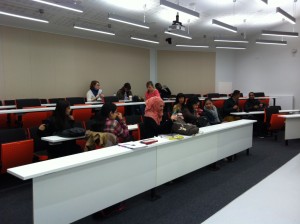Why?
Think-Group-Share creates an engaging moment in lesson that capitalises on discussion and reflection and has a positive impact on student understanding and performance (Habel and Stubbs, 2014).
Technique
This activity is a modified version of Think-Pair-Share and explores the use of technology enriched learning. It goes beyond getting an answer “right” and focuses on high-level reasoning and reflection. The data gathered by students’ answers using clickers or their own devices is good for feedback and students also feel more confident about participating, as they feel supported by their group.
This works for both small groups and large ones. Ask a question students can answer individually, using clickers or their own devices (using PollEverywhere or Socrative, for instance); give them time to think, make notes, etc. Open questions are more likely to generate more discussion and higher order thinking. Once everyone votes, don’t reveal the correct answer.
Get students in groups of no more than 6 and ask each member to explain the reasoning behind their answer to the group; the group has to then vote on the correct answer and one group representative answers the same question again. Reveal the individual and the group answers and lead a class-wide discussion about the strengths and weaknesses of each potential answer.
Reveal the correct answer.
Here’s an excellent example of this activity in practice, with the pedagogy also made explicit.
Technology: Tablets, phones, or clickers.
Tips: If you’re in AG24A or A109, with a small group, encourage students to organize the chairs for group work, or set up the room in Cabaret style. If you’re in BLG07, make the best use of the swivel chair seating.
Online suggestion
This activity can be done online using Moodle groups, a Moodle forum, and PollEverywhere.
Favourite room for this activity
BLG07/A112/ D222/ AG24B
For more ideas on group work activities in flexible learning spaces visit http://tinyurl.com/LSgroupwork.
References
This blog draws on the following works:
Barkley, E.F., Cross, K.P., and Major, C.H. 2005. Collaborative Learning Techniques: A Handbook for College Faculty. San Francisco: Jossey-Bass.
Caldwell, J.E. 2007. Clickers in the large classroom: current research and best-practice tips. CBE Life Sciences Education [Online]. 6, pp. 9-20. [Accessed 17 July 2014]. Available from: http://www.lifescied.org/content/6/1/9.full .
Hancock. 2011. Think-Pair-Share lecture. [Online]. [Date Accessed 23 June 2014]. Available from: http://serc.carleton.edu/details/files/19471.html.
Habel, C., and Stubbs, M. 2014. Mobile phone voting for participation in a large compulsory law course. Research in Learning Technology. 22: 19537.





Leave a Reply